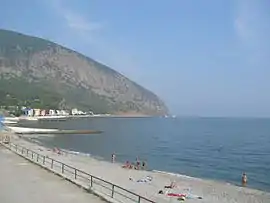Ayu-Dag
Ayu-Dag (Crimean Tatar: Ayuv Dağ, Russian: Аю-Даг, Ukrainian: Аю-Даг, Greek: Αγια (Aya - "Holy"[1])) is a summit of Crimea. It is also known under the Russified name Medved'-gora (Bear mountain) (Russian: Медведь-гора, Ukrainian: Ведмідь-гора). The summit is located 16 km north-east from Yalta between the towns of Gurzuf and Partenit.
| Ayu-Dag | |
|---|---|
 Ayu-Dag. View from Artek's beach | |
| Highest point | |
| Elevation | 572 m (1,877 ft) |
| Coordinates | 44°33′N 34°20′E |
| Geography | |
| Location | Crimea |
| Parent range | Crimean Mountains |
Its Ancient Greek name was Κριοῦ μέτωπον (Kriou Metopon), meaning Ram's Brow.[2] The Slavic language variants of the mountain's name are translations from the Crimean Tatar name and mean Bear Mountain ("bear"-медведь in Russian, ведмідь in Ukrainian, ayuv in Crimean Tatar; "mountain"-гора in Russian and Ukrainian, dağ in Crimean Tatar).
The mountain is a laccolith. Today its territory is a Nature reserve (5.5 km2). There is a pioneer children's camp Artek near Ayu-Dag which is well known internationally. The eastern slopes of Ayu-Dag lead to an ancient settlement Partenit.
Remains of an early-medieval settlement and a number of churches were discovered here. In the 9th-10th centuries it was a well-known seaport, bound with cities of the Byzantine Empire. The western slopes lead to Artek.
References
- Grinevetsky, Sergei R., et al. “The Black Sea Encyclopedia.” Springer, (2014), p. 63
- Strabo, Geography, Book VII.4.3, X.4.2,5.
| Wikimedia Commons has media related to Ayu-Dag. |
